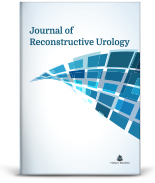Objective: Renal transplantation is the primary treatment method for end-stage kidney disease. Many reasons such as surgical reasons and infection may cause urological complications after transplantation. Management of renal transplantation urinary complications requires respectable surgical experience. In this study, we aimed to present the management of patients who require surgical reconstruction after renal transplantation at our center. Material and Methods: The data of 16 patients who underwent reconstructive surgery after transplantation were reviewed retrospectively. The patients' demographic data were evaluated. Which reconstructive method was applied to the patients, timing of surgical correction after transplantation, pre and post-surgical glomerular filtration rate (GFR) were evaluated. Result: Them mean age of the patients was 35.6 years. The mean time from transplantation to reconstructive surgery was 312 days. The average postoperative hospitalization time was 11.2 days. The earliest complication was total ureteral necrosis seen on the 21st postoperative day and the latest complication was vesicoureteral reflux (VUR) in our series. In patients who developed VUR, VUR was seen more than 6 months after the operation. Nephrostomy was placed in 75% of patients. Ureteroneocystostomy was applied to 3 patients (18.7%), one was applied with Boari flap, and two were applied with modified Lich-Gregoir technique. Pre-operative GFR inter-quantile range (IQR): 35.6-70.3, postoperative first-month GFR IQR: 47.4-69.5, third postoperative months GFR IQR: 50-74.5 were detected. A significant difference was observed between preoperative GFR and postoperative third month GFR (p=0.007). Conclusion: Reconstructive surgery following kidney transplantation is a challenging but effective method. Even if it is performed in different centers, complications after transplantation are likely to occur.
Keywords: Renal transplantation; complications; reoperation
Amaç: Böbrek transplantasyonu, son dönem böbrek yetersizliğinde esas tedavi yöntemidir. Cerrahi teknik, enfeksiyon gibi birçok sebep transplantasyon sonrası ürolojik komplikasyon gelişmesine sebep olabilir. Transplantasyon sonrası ürolojik komplikasyonların yönetimi iyi bir cerrahi tecrübe gerektirir. Bu çalışmada, merkezimizde böbrek transplantasyonu sonrası cerrahi rekonstrüksiyonu yapılan hastaların yönetimini sunmayı amaçladık. Gereç ve Yöntemler: Transplantasyon sonrası rekonstrüktif cerrahi uygulanan 16 hastanın verileri geriye dönük olarak incelendi. Hastaların demografik verileri değerlendirildi. Hastalara hangi rekonstrüktif yöntemin uygulandığı, transplantasyon sonrası cerrahi düzeltmenin zamanlaması ve cerrahi öncesi ve sonrası glomerüler filtrasyon hızı [glomerular filtration rate (GFR)] değerlendirildi. Bulgular: Hastaların ortalama yaşı 35,6'dır. Transplantasyondan rekonstrüktif cerrahiye kadar geçen ortalama süre 312 gündü. Operasyon sonrası ortalama yatış süresi 11,2 gün idi. Bizim serimizde en erken komplikasyon postoperatif 21. günde görülen total üreteral nekroz, en geç komplikasyon vezikoüreteral reflü (VUR) idi. VUR gelişen hastalarda VUR operasyondan 6 aydan fazla süre geçtikten sonra görülmüştür. Hastaların %75'ine nefrostomi takıldı. Bir hastaya Boari flap yöntemi, 2 hastaya modifiye Lich-Gregoir tekniği ile toplamda 3 (%18,7) hastaya üreteroneosistostomi yapıldı. Ameliyat öncesi GFR çeyrekler açıklığı [inter-quantile range (IQR)]: 35,6- 70,3 ameliyat sonrası 1. ay GFR IQR: 47,4-69,5, ameliyat sonrası 3. ay GFR IQR: 50-74,5 olarak belirlendi. Ameliyat öncesi GFR ile ameliyat sonrası 3. ay GFR arasında anlamlı bir fark gözlendi (p=0,007). Sonuç: Böbrek nakli sonrası rekonstrüktif cerrahi zorlu ama etkili bir yöntemdir. Farklı merkezlerde yapılsa bile nakil sonrası komplikasyonların oluşması muhtemeldir.
Anahtar Kelimeler: Böbrek transplantasyonu; komplikasyonlar; reoperasyon
- Johansen KL, Chertow GM, Gilbertson DT, Herzog CA, Ishani A, Israni AK, et al. US Renal Data System 2021 Annual Data Report: Epidemiology of Kidney Disease in the United States. Am J Kidney Dis. 2022;79(4 Suppl 1):A8-A12. [Crossref] [PubMed] [PMC]
- Mäkisalo H, Eklund B, Salmela K, Isoniemi H, Kyllönen L, Höckerstedt K, et al. Urological complications after 2084 consecutive kidney transplantations. Transplant Proc. 1997;29(1-2):152-3. [Crossref] [PubMed]
- Shoskes DA, Hanbury D, Cranston D, Morris PJ. Urological complications in 1,000 consecutive renal transplant recipients. J Urol. 1995;153(1):18-21. [Crossref] [PubMed]
- Cimic J, Meuleman EJ, Oosterhof GO, Hoitsma AJ. Urological complications in renal transplantation. A comparison between living-related and cadaveric grafts. Eur Urol. 1997;31(4):433-5. [Crossref] [PubMed]
- El-Mekresh M, Osman Y, Ali-El-Dein B, El-Diasty T, Ghoneim MA. Urological complications after living-donor renal transplantation. BJU Int. 2001;87(4):295-306. [Crossref] [PubMed]
- Giessing M. Transplant ureter stricture following renal transplantation: surgical options. Transplant Proc. 2011;43(1):383-6. [Crossref] [PubMed]
- Choi YS, Kim KS, Choi SW, Bae WJ, Hong SH, Lee JY, et al. Ureteral complications in kidney transplantation: analysis and management of 853 consecutive laparoscopic living-donor nephrectomies in a single center. Transplant Proc. 2016;48(8):2684-8. [Crossref] [PubMed]
- Praz V, Leisinger HJ, Pascual M, Jichlinski P. Urological complications in renal transplantation from cadaveric donor grafts: a retrospective analysis of 20 years. Urol Int. 2005;75(2):144-9. [Crossref] [PubMed]
- Juaneda B, Alcaraz A, Bujons A, Guirado L, Díaz JM, Martí J, et al. Endourological management is better in early-onset ureteral stenosis in kidney transplantation. Transplant Proc. 2005;37(9):3825-7. [Crossref] [PubMed]
- Kwong J, Schiefer D, Aboalsamh G, Archambault J, Luke PP, Sener A. Optimal management of distal ureteric strictures following renal transplantation: a systematic review. Transpl Int. 2016;29(5):579-88. [Crossref] [PubMed]
- Faenza A, Nardo B, Fuga G, Liviano-D'Arcangelo G, Grammatico F, Montalti R, Bertelli R, et al. Urological complications in kidney transplantation: ureterocystostomy versus uretero-ureterostomy. Transplant Proc. 2005;37(6):2518-20. [Crossref] [PubMed]
- Faenza A, Nardo B, Catena F, Scolari MP, d'Arcangelo GL, Buscaroli A, Rossi C, Zompatori M. Ureteral stenosis after kidney transplantation. A study on 869 consecutive transplants. Transpl Int. 1999;12(5):334-40. [Crossref] [PubMed]
- Gomes G, Nunes P, Castelo D, Parada B, Patrão R, Bastos C, Roseiro A, Mota A. Ureteric stent in renal transplantation. Transplant Proc. 2013;45(3):1099-101. [Crossref] [PubMed]
- Dupont PJ, Psimenou E, Lord R, Buscombe JR, Hilson AJ, Sweny P. Late recurrent urinary tract infections may produce renal allograft scarring even in the absence of symptoms or vesicoureteric reflux. Transplantation. 2007;84(3):351-5. [Crossref] [PubMed]
- Salomon L, Saporta F, Amsellem D, Hozneck A, Colombel M, Patard JJ, et al. Results of pyeloureterostomy after ureterovesical anastomosis complications in renal transplantation. Urology. 1999;53(5):908-12. [Crossref] [PubMed]
- Berli JU, Montgomery JR, Segev DL, Ratner LE, Maley WR, Cooper M, et al. Surgical management of early and late ureteral complications after renal transplantation: techniques and outcomes. Clin Transplant. 2015;29(1):26-33. [Crossref] [PubMed]
- Karam G, Maillet F, Parant S, Soulillou JP, Giral-Classe M. Ureteral necrosis after kidney transplantation: risk factors and impact on graft and patient survival. Transplantation. 2004;78(5):725-9. [Crossref] [PubMed]







.: İşlem Listesi